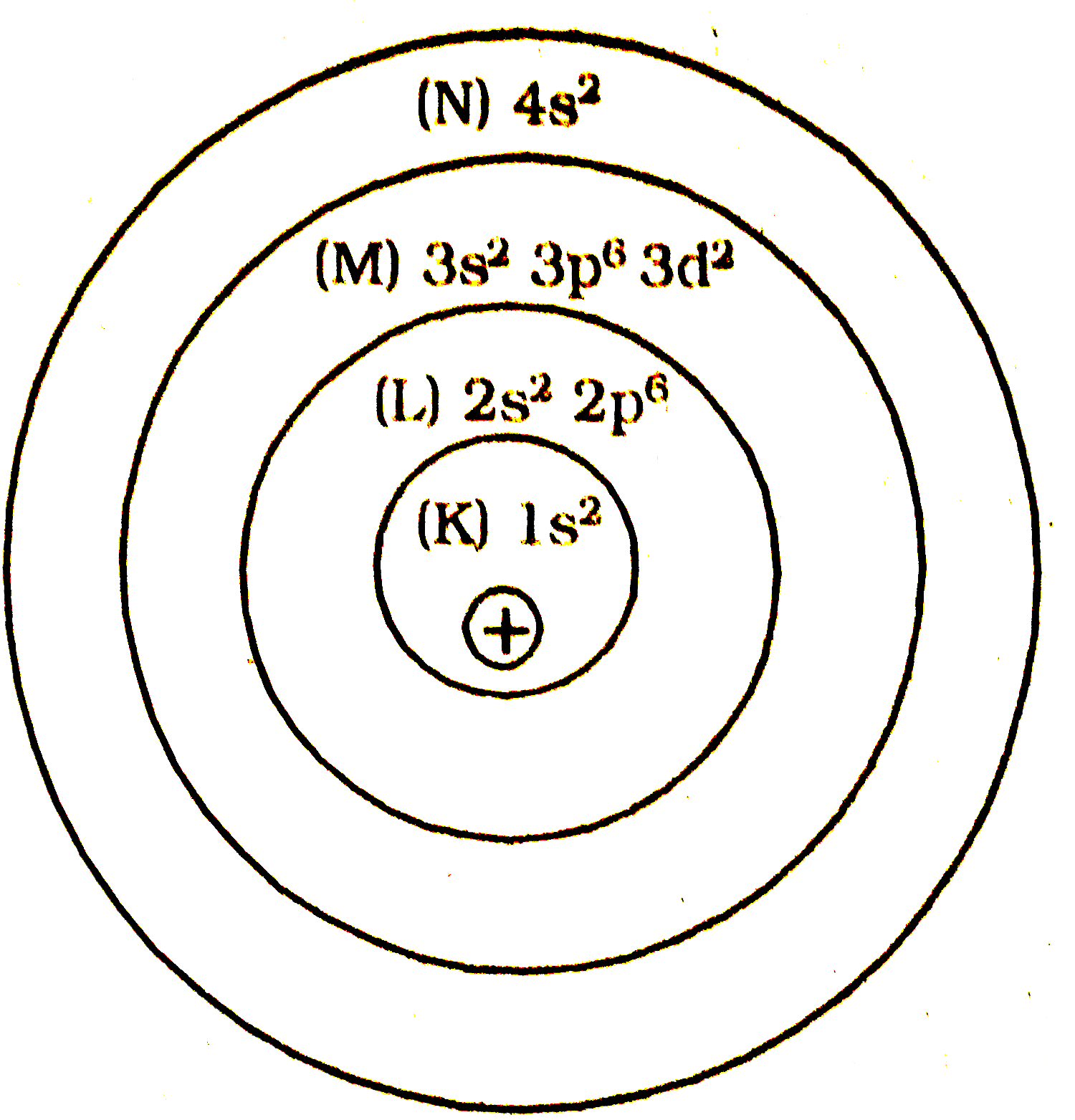In an atom the number of electrons in N - Shell is equal to the number of electrons in K, L and M shells. Answer the question.
Write the electronic configuration of the elements.
Explanation :
K=1s2(2) electrons
L=2s22p6(8) electrons
M = 3s23p63d10 (18) electrons
Total (28) electrons
N=4s24p64d104f10 (28) electrons
To fill 4f10,1s2,2s22p22p63s23p64s23d104p65s24d105p66s2 should be filled Hence , the electronic configuration is 1s22s22p63s23p64s23104p65s24d105p66s24f10 . Solution in Telugu
The electronic configuration of element is
1s22s22p63s23p64s23d104p65s24d106s24f10.
Topper's Solved these Questions
- STRUCTURE OF ATOM BOOK - VGS PUBLICATION-BRILLIANTCHAPTER - STRUCTURE OF ATOM EXERCISE - CREATIVE QUESTIONS FOR NEW MODEL EXAMINATION ( SECTION - III 2 MARKS QUESTIONS )
38 Videos
- REFLECTION AND REFRACTIONBOOK - VGS PUBLICATION-BRILLIANTCHAPTER - REFLECTION AND REFRACTIONEXERCISE - EXERCISE
24 Videos
- SUMMATIVE ASSESSMENTBOOK - VGS PUBLICATION-BRILLIANTCHAPTER - SUMMATIVE ASSESSMENTEXERCISE - SUMMATIVE ASSESSMENT
28 Videos
Similar Questions
Explain Hund's rule with an example .
View SolutionThe light reflected by a plane mirror will form a real image
View SolutionWrite any two uses of convex mirror in day to day life.
View SolutionAn element has 2 electrons in K shell, 8 electrons in L shell, 13 electrons in M shell and one electron in N shell. The element is
View SolutionAn atom has 2 electrons in K shell, 8 electrons in L shell and 6 electrons in M shell. The number of s-electrons present in that element is
View SolutionIn an atom the number of electrons in M - shell is equal to the number of electrons in the K and L - shell . Answer the question. Explanation : 1) Number of electrons in K-shell (1 s^(2)) = 2 Number of electrons in L-shell (2s^(2) sp^(6)) = 8 Total number of electrons in k & L shells = 10 2) Given that number of electrons in M-shell is equal to number of electrons in K& L- shells 3) Hence number of electrons in M-shell (3s^(2) 3p^(6) 3d^(2)) = 10 4) But , we know that before filling of 3d orbital 4s should be filled (4s^(2)) 5) So , electronic configuration is 1s^(2) 2s^(2) 2p^(6) 3s^(2) 3p^(6) 4s^(2) 3d^(2) Which is the outermost cell ?
View SolutionIn an atom the number of electrons in M - shell is equal to the number of electrons in the K and L - shell . Answer the question. Explanation : 1) Number of electrons in K-shell (1 s^(2)) = 2 Number of electrons in L-shell (2s^(2) sp^(6)) = 8 Total number of electrons in k & L shells = 10 2) Given that number of electrons in M-shell is equal to number of electrons in K& L- shells 3) Hence number of electrons in M-shell (3s^(2) 3p^(6) 3d^(2)) = 10 4) But , we know that before filling of 3d orbital 4s should be filled (4s^(2)) 5) So , electronic configuration is 1s^(2) 2s^(2) 2p^(6) 3s^(2) 3p^(6) 4s^(2) 3d^(2) How many electrons are there in its outermost shell ?
View SolutionIn an atom the number of electrons in M - shell is equal to the number of electrons in the K and L - shell . Answer the question.
Explanation :
1) Number of electrons in K-shell (1s2)=2
Number of electrons in L-shell (2s2sp6)=8
Total number of electrons in k & L shells = 10
2) Given that number of electrons in M-shell is equal to number of electrons in K& L- shells
3) Hence number of electrons in M-shell (3s23p63d2)=10
4) But , we know that before filling of 3d orbital 4s should be filled (4s2)
5) So , electronic configuration is 1s22s22p63s23p64s23d2

What is the atomic number of element ?
View SolutionIn an atom the number of electrons in N - Shell is equal to the number of electrons in K, L and M shells. Answer the question. Which is the outermost shell ? Explanation : K = 1 s^(2) (2) electrons L = 2s^(2) 2p^(6) (8) electrons M = 3s^(2) 3p^(6) 3d^(10) (18) electrons Total (28) electrons N = 4s^(2) 4p^(6) 4d^(10) 4f^(10) (28) electrons To fill 4f^(10) , 1s^(2) , 2s^(2) 2p^(2) 2p^(6) 3s^(2) 3p^(6) 4s^(2) 3d^(10) 4p^(6) 5s^(2) 4d^(10) 5p^(6) 6s^(2) should be filled Hence , the electronic configuration is 1s^(2) 2s^(2) 2p^(6) 3s^(2) 3p^(6) 4s^(2) 3^(10) 4p^(6) 5s^(2) 4d^(10) 5p^(6) 6s^(2) 4f^(10) .
View SolutionIn an atom the number of electrons in N - Shell is equal to the number of electrons in K, L and M shells. Answer the question. How many electrons are there in its outermost shell ? Explanation : K = 1 s^(2) (2) electrons L = 2s^(2) 2p^(6) (8) electrons M = 3s^(2) 3p^(6) 3d^(10) (18) electrons Total (28) electrons N = 4s^(2) 4p^(6) 4d^(10) 4f^(10) (28) electrons To fill 4f^(10) , 1s^(2) , 2s^(2) 2p^(2) 2p^(6) 3s^(2) 3p^(6) 4s^(2) 3d^(10) 4p^(6) 5s^(2) 4d^(10) 5p^(6) 6s^(2) should be filled Hence , the electronic configuration is 1s^(2) 2s^(2) 2p^(6) 3s^(2) 3p^(6) 4s^(2) 3^(10) 4p^(6) 5s^(2) 4d^(10) 5p^(6) 6s^(2) 4f^(10) .
View SolutionIn an atom the number of electrons in N - Shell is equal to the number of electrons in K, L and M shells. Answer the question.
What is the atomic number ?
Explanation :
K=1s2(2) electrons
L=2s22p6(8) electrons
M = 3s23p63d10 (18) electrons
Total (28) electrons
N=4s24p64d104f10 (28) electrons
To fill 4f10,1s2,2s22p22p63s23p64s23d104p65s24d105p66s2 should be filled Hence , the electronic configuration is 1s22s22p63s23p64s23104p65s24d105p66s24f10 .
View SolutionAn element has 2 electrons in its K-shell. 8 electrons in L-shell, 13 electrons in M-shell and one electron in N-shell. The element is
View Solutionएक परमाणु कोश K- कोश में 2-इलेक्ट्रॉन L- कोश में 8- इलेक्ट्रॉन तथा M- कोश में 8- इलेक्ट्रॉन रखता है तो तत्व में P इलेक्ट्रॉनों की संख्या है
View SolutionAn element has 2 electrons in its K-shell. 8 electrons in L-shell, 13 electrons in M-shell and one electron in N-shell. The element is
View SolutionThe electronic configuration of an element is written as follows: 1s22s22p63s23p63d84s2
The screening constant value for an electron in 3s is identical with that of an electron present in
View Solution